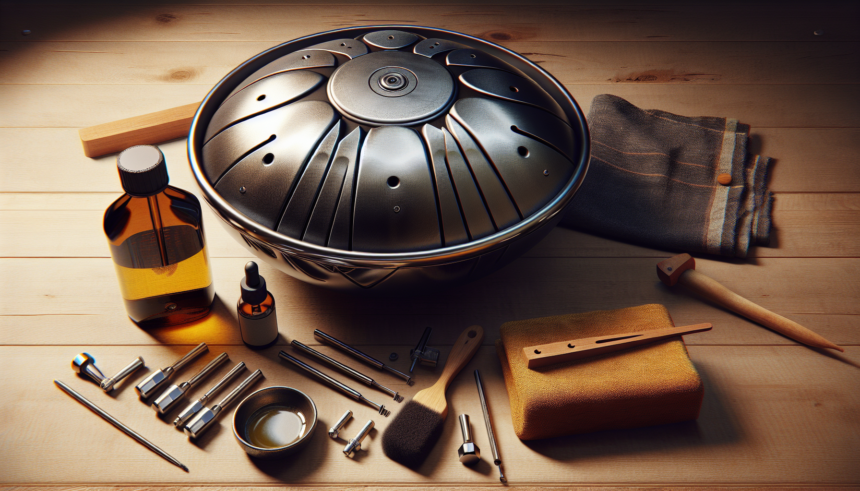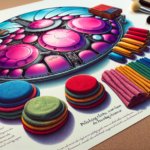The handpan is a remarkable musical instrument, a relatively recent invention that has won the hearts of musicians and listeners alike with its ethereal, resonant sounds. While its beauty and sound are undeniable, the handpan’s construction and maintenance should not be overlooked. To achieve the best performance and longevity from a handpan, it is crucial to understand the materials used in its construction and the specific maintenance needs associated with each type. This guide provides an in-depth look at the primary materials used in handpans and offers comprehensive maintenance tips to ensure your handpan remains in optimal condition.
Materials Used in Handpans
- Nitrided Steel
Nitrided steel is a popular material in handpan construction due to its durability and resistance to corrosion. The nitriding process involves exposing the steel to heat and nitrogen, creating a hard, corrosion-resistant surface while retaining the metal’s inner toughness.
Nitrided steel handpans are known for their rich, warm tones and increased longevity. They are a preferred choice for many professional handpan players who seek reliable performance and minimal maintenance needs.
- Stainless Steel
Stainless steel handpans are also highly sought after due to their exceptional resistance to rust and corrosion. Stainless steel differs from nitrided steel in its composition; it contains chromium, which forms a passive layer of chromium oxide on the steel’s surface, protecting it from rust.
The sound of stainless steel handpans tends to be brighter and more resonant compared to those made from nitrided steel. This material choice provides a different auditory experience, making it suitable for artists seeking a unique sound profile.
- Raw Steel
Raw steel handpans are less common but offer a distinct sound and aesthetic. These handpans are constructed from untreated steel, which can be more susceptible to rust and corrosion without proper care.
Despite requiring more frequent maintenance, raw steel handpans can provide earthy, authentic tones praised by many musicians. However, they demand attentive upkeep to prevent rust and sustain their sound quality.
Maintenance Needs and Tips
- Cleaning
Regular cleaning of your handpan is essential to maintain its appearance and acoustic properties. Regardless of the material, it is recommended to wipe down the handpan with a soft, dry cloth after each use to remove any oils, sweat, or dirt that might have accumulated.
For a deeper clean, a slightly damp cloth can be used to gently wipe the surface. Avoid using abrasive materials or harsh chemicals, as they can damage the finish and affect the sound quality. For stubborn marks or residues, you can use a mild, pH-neutral soap solution followed by a thorough drying with a soft cloth.
- Oiling
Oiling is particularly important for nitrided and raw steel handpans to prevent rust and corrosion. Applying a thin layer of oil forms a protective barrier against moisture and air, minimizing the risk of rust.
Use a high-quality, non-toxic oil such as Ballistol, Froglube, or a specialized handpan oil. After cleaning your handpan, apply a small amount of oil to a soft cloth and gently rub it over the surface, ensuring even coverage. Be sure to wipe off any excess oil to avoid a sticky residue.
- Storage
Proper storage of your handpan is critical to safeguarding its condition. Store your handpan in a cool, dry place away from direct sunlight and extreme temperatures. Humidity and temperature fluctuations can cause the metal to expand and contract, potentially affecting the tuning and structural integrity of the instrument.
A padded handpan case is highly recommended for additional protection against physical damage. When transporting your handpan, always use a case to minimize the risk of dents, scratches, and other kinds of damage.
- Tuning and Repairs
Handpans may occasionally require tuning or repairs to maintain their sound quality. It is advised to consult a professional handpan tuner or maker for any adjustments, as improper handling can lead to irreversible damage.
Regularly check your handpan for any signs of detuning or damage, such as changes in pitch, buzzing sounds, or visible dents. Early detection and professional repair can extend the life of your handpan and ensure it continues to produce beautiful music.
- Preventive Measures
Beyond regular cleaning and oiling, there are several preventive measures you can take to maintain your handpan. Avoid placing heavy objects on your handpan, as this can cause dents or deformities. Additionally, refrain from playing the handpan with excessive force, which can damage the instrument and affect its tuning.
Handling your handpan with clean, dry hands can also help reduce the transfer of oils and dirt onto the surface, decreasing the frequency of needed cleanings and oiling.
Conclusion
Understanding the different materials used in handpan construction and their maintenance needs is crucial for any handpan owner. Whether your handpan is made of nitrided steel, stainless steel, or raw steel, proper care and maintenance will enhance its longevity and ensure it continues to produce beautiful sounds.
By incorporating regular cleaning, oiling, appropriate storage, and preventive measures into your routine, you can enjoy your handpan for years to come while preserving its unique tonal qualities. Remember, a well-maintained handpan is not only a long-lasting instrument but also a source of continuous joy and inspiration.
FAQs
1. How often should I clean my handpan?
It is recommended to wipe down your handpan with a soft, dry cloth after each use. For a deeper clean, aim to wipe it with a slightly damp cloth and a mild, pH-neutral soap solution every few weeks. Regular cleaning helps maintain its appearance and sound quality.
2. Can I use any oil for my handpan?
No, it is best to use a high-quality, non-toxic oil such as Ballistol, Froglube, or specialized handpan oils. These oils provide the necessary protection against rust without leaving harmful residues. Avoid using any abrasive or household oils that could damage your handpan.
3. What is the best way to store my handpan?
Store your handpan in a cool, dry place away from direct sunlight, humidity, and extreme temperatures. Using a padded handpan case can provide additional protection against physical damage and environmental factors.
4. How often does a handpan need tuning?
The frequency of tuning can vary depending on how often you play and how well you maintain your handpan. Generally, a handpan may need tuning every 1-2 years. Consult a professional tuner if you notice any changes in pitch or sound quality.
5. What should I do if my handpan gets a dent?
If your handpan gets a dent, it is crucial to seek the assistance of a professional handpan tuner or maker. Attempting to fix the dent yourself can lead to further damage. Professionals have the tools and expertise to assess and repair the dent properly.





